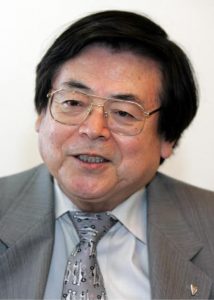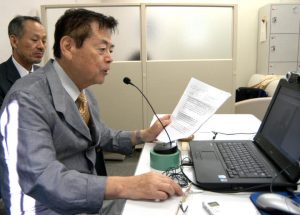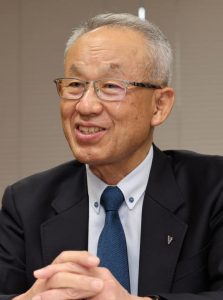My guidepost, Hiroshima pioneers: Makoto Matsumura, 75, president of Hiroshima Prefectural Medical Association, speaks about Shizuteru Usui
Feb. 3, 2025
Mission as “physician in A-bombed Hiroshima”
by Kana Kobayashi, Staff Writer
Makoto Matsumura is in his fifth year as president of the Hiroshima Prefectural Medical Association. Dr. Matsumura works to coordinate members of the association as well as takes on the responsibility of a variety of other roles. He travels to North and South America to carry out health examinations for atomic bomb survivors there and also serves as president of the Japan Chapter of International Physicians for the Prevention of Nuclear War (IPPNW). He always keeps in mind his “mission as a physician in the A-bombed Hiroshima,” an attitude he learned from Shizuteru Usui (1937–2012), former president of the Hiroshima Prefectural Medical Association who worked on the issue of nuclear weapons abolition while standing at the side of A-bomb survivors.
Mr. Matsumura first met Mr. Usui, a physician committed to helping A-bomb survivors and to engaging in anti-nuclear activities while managing his private-practice, internal medicine clinic in Hiroshima City, around 30 years ago. He was impressed by Mr. Usui, who “argued with confidence” for reform of the association at a campaign speaking event when running against an older candidate seeking election to serve as president of the Hiroshima City Medical Association. “I admired him from afar, thinking he was an amazing person.” When Mr. Usui became president of the Hiroshima City Medical Association in 1998, Mr. Matsumura offered him support while serving as a board member. Up close, he witnessed the work of Mr. Usui, who dedicated himself to the development of community medicine and to communicating his message in the form of published books and other writings.
As a member of IPPNW and the medical association, Mr. Usui also visited nuclear-affected areas around the world early on, including the former Soviet Union in 1990 before its collapse, as well as Kazakhstan, Belarus and Ukraine in the early 1990s, countries that had been contaminated by nuclear testing and a nuclear accident during the former Soviet era. He learned of the reality of radiation exposure by interviewing local residents and exchanging opinions with local physicians.
The starting point of his medical career seems to have been his experience in the atomic bombing at the age of eight near his home, located around 2.3 kilometers from the hypocenter. He survived the bombing, but witnessed severely burned people fleeing from the central part of the city. When he learned about the wounded physicians who had provided aid and treatment to the victims, he wrote in his own book about how he also “wanted to save wounded people by becoming a physician in the future.”
In 2004, Mr. Usui became president of the Hiroshima Prefectural Medical Association, putting his heart into the work of providing health examinations for A-bomb survivors living in the United States and other countries. The medical association began providing examinations for those living in the United States in 1977, based on requests from survivors living there, work that was positioned in 2002 as being part of the national government’s efforts to support survivors and a project that continues to this day.
One day, Mr. Usui sounded out Mr. Matsumura about joining a group of physicians providing health examinations overseas. “I immediately accepted his request,” Mr. Matsumura said. As a second-generation A-bomb survivor, he had grown up watching his A-bomb survivor mother suffer and worry about health issues that survivors typically did not raise even with their own families. He also would come into contact with many A-bomb survivors in his daily practice. “A-bomb survivors living overseas must be suffering even more,” he thought to himself.
In 2005, Mr. Matsumura joined a group of physicians dispatched to the United States. Since then, he has made frequent visits to the United States as well as Brazil and other South American countries. “When coming into contact with me and my Hiroshima dialect, they feel nostalgic and reassured.” In that way, he senses the importance of the program.
Under the Atomic Bomb Survivors Relief Law, A-bomb survivors living overseas are now entitled to nearly the same level of benefits as those provided to survivors living in Japan. But, for a long time, they had been locked out of relief provided by the law. In the 2000s, the movement by survivors living outside of Japan to appeal the law’s limits grew active with the aim of further advancing the government’s relief measures. Many physicians had an instinctive aversion to any movement of a “political” nature, but Mr. Usui called for enhancements in relief provided from a humanitarian standpoint. “A-bomb survivors are A-bomb survivors wherever they are,” he would say. He also showed compassion to A-bomb survivors not covered by the relief law living in North Korea, a country that does not enjoy diplomatic relations with Japan, visiting that country in 2008 and 2011. On those visits, he met with survivors and interviewed them about their health status.
Mr. Matsumura has followed in Mr. Usui’s footsteps. In 2013, when he was president of the Hiroshima City Medical Association, he formed a group of physicians who are second-generation survivors of the Hiroshima bombing to pass on A-bomb survivors’ memories of the bombing and raise the standard of medical treatment for survivors. He also planned a public lecture to which he invited A-bomb survivors living overseas. “Dr. Usui told me that when he thought about what to do, he would first return to the starting point of the A-bombed Hiroshima. I do the same.” He acts by setting an example for future generations of physicians.
Profile
Makoto Matsumura
Born in Hiroshima City’s Saeki Ward, Mr. Matsumura graduated from Hiroshima University Medical School in 1974. After working in the Department of Surgery No. 1 at Hiroshima University Hospital, he went into private practice, opening Matsumura Clinic, which specializes in cardiology and surgery. Having served in a variety of positions, including board member of the Hiroshima City Medical Association and vice-president of the Hiroshima Prefectural Medical Association, he took on the role of president of the Hiroshima City Medical Association during the period 2013–2020. He assumed his current position as president of the Hiroshima Prefectural Medical Association in June 2020. He lives in the city’s Saeki Ward.
Keywords
Health examinations for A-bomb survivors living in the United States
In 1977, the Hiroshima Prefectural Medical Association, in cooperation with the Radiation Effects Research Foundation (RERF), initiated a health examination program for atomic bomb survivors living in the United States, the nation that had dropped the atomic bombs. The survivors suffered from a lack of understanding among local physicians about aftereffects from exposure to A-bomb radiation, concerns about their health, and language barriers, repeatedly requesting that the Japanese national government and the Hiroshima City government dispatch specialist physicians. Since then, medical teams have been sent to the United States every other year. Starting in 1985, the program was led by the Hiroshima and Nagasaki prefectural governments and began additionally sending groups of physicians to South American countries. In 2002, the program was positioned as being part of the national government’s efforts to support A-bomb survivors living overseas.
(Originally published on February 3, 2025)










